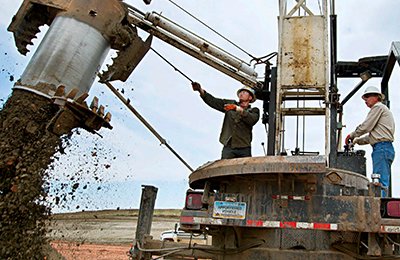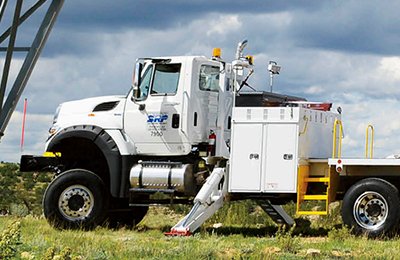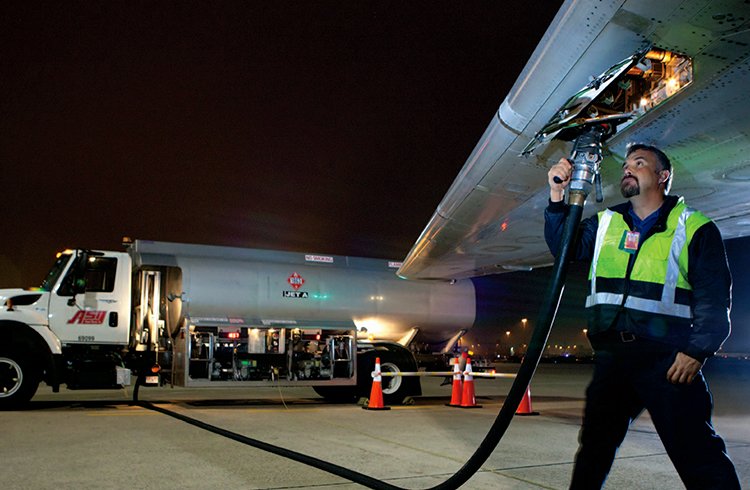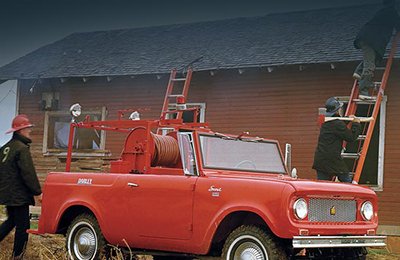WorkStar Catalina
At first only a few tendrils of smoke snake out of the dense underbrush and then quickly disappear in the cold, gusty winds of the exposed ridgeline. It doesn’t take long, however, for the smoke to thicken to the point where the oak trees are obscured and thick waves of dark gray are rolling across a nearby clearing.
Like the bugle of the cavalry, the roar of an International® WorkStar® fire truck announces itself: It’s coming to the rescue. Bursting from little more than a goat path on the side of the mountain, the red Los Angeles County Fire Department (LACoFD) engine confronts the thick smoke head on, spraying a powerful stream of water from a nozzle just above its front bumper.
Captain Gary Black, an engineer and firefighter, jumps from the double cab and within a couple of minutes has the hoses hooked up and ready to saturate the area.
That’s when the smoke machine is turned off.
Outside the perimeter of the fire drill, nearly a dozen onlookers from the LACoFD, Navistar and Kovatch Mobile Equipment (KME) applaud Captain Black, his crew and, especially, one of the most unusual additions to the department’s 1,700 fire-fighting vehicles: The audience has gathered to see LA County Fire Engine 55 do its stuff.
Chief Craig Weeks, who is in charge of the fleet that covers 2,300 square miles of both intensely urban spaces and remote wild lands watched over by 170 fire stations, especially enjoys the truck’s performance. It was he who took suggestions from Captain Black’s predecessor, translated them into specifications, and put them out for bid.
The specs raised a lot of eyebrows, and more than one TEM told Chief Weeks that the vehicle he wanted couldn’t be built. Weeks, a calm, confident man who knows his business, asked them in return, “Do you mean it can’t be done, or you’ve just never done it before?”
What the LACoFD wanted was a Type 3 vehicle with a significantly increased water capacity to serve the most unique and challenging station under its command, a station separated from the mainland by 22 miles of Pacific Ocean.
Santa Catalina Island is a deceptively wild and untamed place. The 74-square-mile island is widely known for picturesque Avalon village, its casino and popular harbor. But inland are vertical peaks rising up to 1,600 feet and narrow canyons and arroyos that are barely accessible by foot. Dry grasslands and the infamous Channel Island winds can be a deadly combination. In 2007, a construction crew accidentally set off a blaze that burned 4,000 acres and virtually surrounded Avalon. A total conflagration was barely averted by a massive response from the mainland LACoFD.
“It’s not a vacation spot for us. It’s one of the most challenging and interesting assignments in the county,” says Captain Black, a 36-year veteran who requested the assignment of running the two-man department. Captain Black is something of a renaissance fireman. In addition to an encyclopedic knowledge of firefighting, he can fix engines, is good with computers, and recently added cartography to his repertoire. “This far from the mainland and with our limited resources, the job requires someone fairly self-sufficient,” he says.
Such a specific assignment required some creative thinking when it came to truck specifications. Chief Weeks’ suggestion was to increase the water tank capacity from 500 gallons to 750 with a pumping speed of 700 gallons per minute. Captain Black believed that the extra capacity was just the edge they needed to handle both brush and structure fires in the time it would take for reinforcements to arrive. The problem, as some of the fire equipment manufacturers saw it, was that the increased water load would make the truck dangerously top-heavy, especially with the relatively short wheel base necessary to make the vehicle maneuverable.
Dean Carriger, a sales rep for KME, didn’t scoff at Weeks’ specs. Instead, he took them back to the designers at KME and asked them to give it a try. The team at KME studied the specs and came up with a solution.
According to Weeks, the all-important test that a truck must pass to satisfy National Fire Protection Association standards is a tilt test. A fully loaded truck is set up on a track and tilted. For a wild-lands vehicle like Engine 55, the requirement is 26 degrees. When KME scored the job in 2010, Carrikyer says, there were a lot of skeptics looking suspiciously at the project.
The first step after landing the LACoFD contract was getting the right International® chassis. The project started with a WorkStar® 4x4 with a four-door double cab and a 5-speed Allison 3000 EVS transmission set on a 185-inch wheelbase. When KME received the chassis from International, they began by installing a polypropylene tank instead of the usual stainless steel to lessen the top-heavy load. KME engineers were also able to position the tank very low on the chassis to compensate for the additional 250 gallons. When Engine 55 went through its tilt test, it performed perfectly.
The island receives up to 10,000 visitors a day during the peak summer months. That’s when Captain Black’s job gets really tough.
“Coming to Catalina is a lot like going to Disneyland, and people are involved in a lot of activities,” Black says later in the day, back at the station in Avalon. At first glance, the station looks like any neat 1960s, California suburban home. Black uses half as his residence and the other half as the station office. “Almost all our incidents can be attributed to visitors. There are rugged activities inland, aircraft accidents at the airport, boat and diving accidents.”
But brush fires and the worrying fact that most of Avalon’s homes are small, wooden bungalows crowded together on narrow streets are the main reasons Weeks and the LACoFD brass decided three years ago to commission something unique for their most remote outpost.
Captain Black explains that they have in place what they call the “Catalina Plan.” In addition to Black and his engineer at the Avalon station, there are the Avalon Fire Department’s five firefighters and 25 volunteers, the 10 members of the Avalon Harbor, six LA County sheriffs, the rangers of the Catalina Island Conservancy and a number of other professionals and volunteers. When a fire or any other incident occurs, Captain Black jumps in his car to assess the situation. If there is any question at all that the local crews might need help, Black implements the Plan and calls to the mainland for backup.
“It takes the mainland crews about 45 minutes to get here by helicopter,” says Captain Black, “so whatever the situation is, we need to do our best to control it during that time.”
Weeks took delivery of the new firetrucks in 2011 and placed them in five stations around the county where they would see a lot of action. “We needed to work the bugs out and see if there were any issues,” says the chief. “If a major problem develops out here, then that’s a 26,000-pound vehicle we have to barge back to the mainland.”
After the smoke drill, Weeks is not only satisfied with Engine 55’s performance, but clearly pleased that he and KME proved the skeptics wrong. “KME not only met all of our specifications,” he notes with a smile, “they were also the low bidder."



